Wildflowers of the Adirondacks:
Pitcher Plant (Sarracenia purpurea)
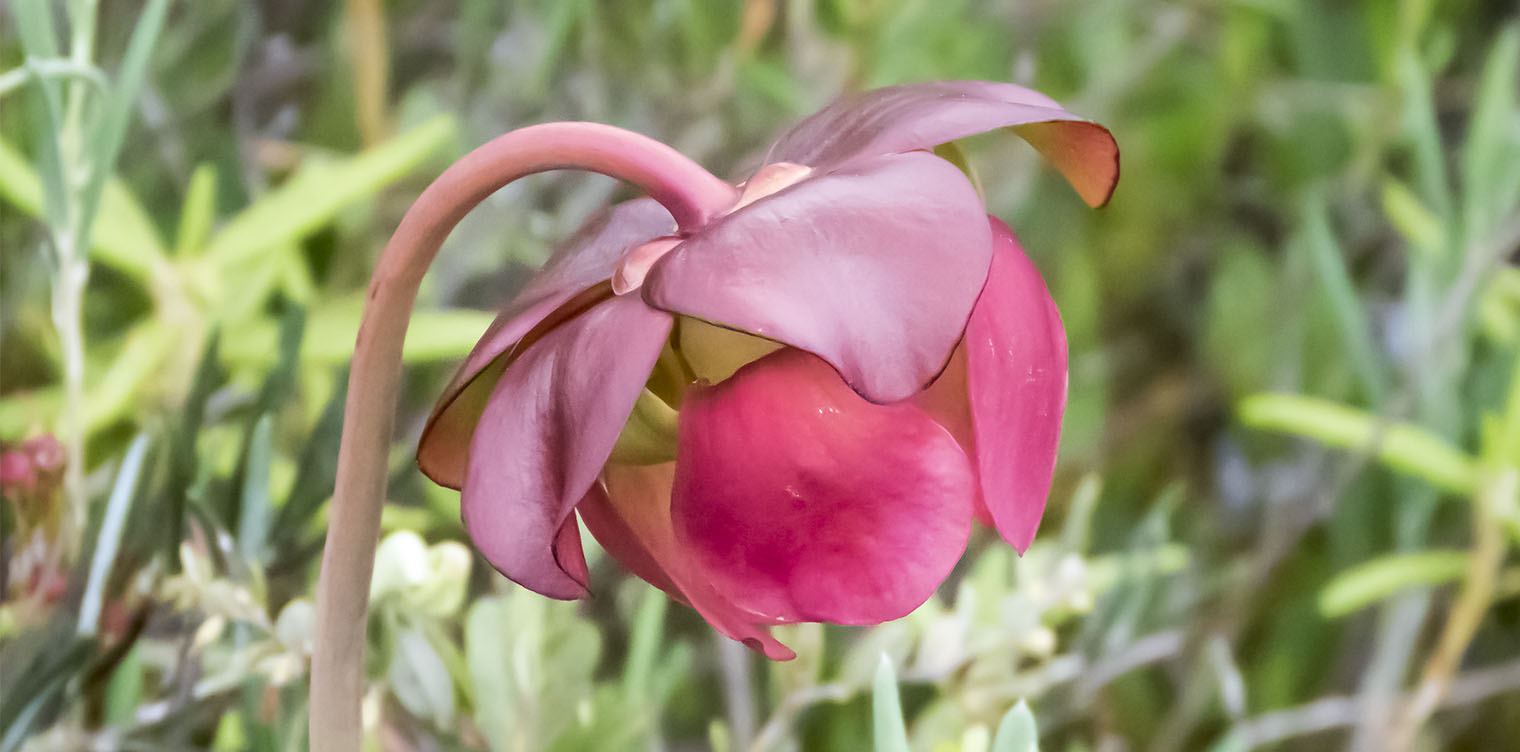
The Pitcher Plant (Sarracenia purpurea) is a carnivorous plant found in peat bogs in the Adirondacks. This habitat is low in essential plant nutrients such as nitrogen, calcium, magnesium, and potassium. Pitcher Plants carry on photosynthesis like other green plants, but supplement their nutrition by capturing and digesting small insects.
- The genus name (Sarracenia) is derived from Michael Sarrazin, a physician born in France in 1659. Sarrazin emigrated to Canada in 1685 and later developed an interest in botany. He reportedly was the first to suggest that Pitcher Plants devour insects and the first to write about the properties of Wild Sarsaparilla.
- The species name (purpurea) is a reference to the dark purple of the leaves.
The common name is a reference to the pitcher-shaped leaves. Other names include Purple Pitcherplant, Northern Pitcher-plant, Northern Purple Pitcherplant, Indian Dipper, Huntsman's Cup, Adam's-Pitcher, Dumb-watch, Frog's Britches, and Whippoorwill-boots. The plant is also known as Side-saddle Flower or Sidesaddle Plant, a reference to the under part of the flower said to be somewhat like the seat of a sidesaddle. Several other names (Fever-cup and Smallpox-plant) refer to the plant's purported medicinal properties.
Identification of Pitcher Plant
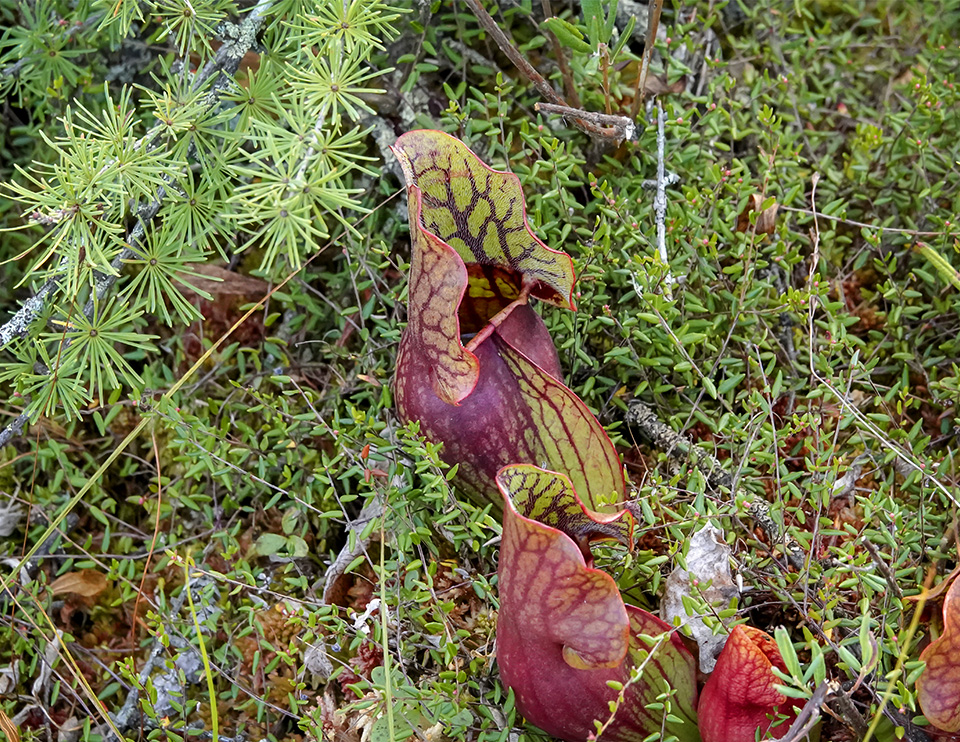
The Pitcher Plant grows about 8 to 24 inches high. Perhaps the most reliable way to identify the Pitcher Plant is by looking for a rosette of tubular leaves growing around the base of the flower stalk. The leaves are up to eight inches long. They vary in color from reddish-green (with purple veins) to purple to purplish red. The reddish colors and veins are attractive to some insects.
The leaves are modified into pitchers, often partly filled with water. Each leaf has five distinct zones:
- The topmost zone consists of a flared flap, with nectar glands and brightly colored veins to attract insect prey. Each flap has two lateral rounded lobes. The inside of the flap is covered with downward-pointing hairs to encourage the prey to descend into the pitcher. They also make it difficult for the prey to crawl back out.
- The second zone consists of a smooth rim inside the pitcher. The prey slides down the smooth vertical surface, which is covered with adhesive cells designed to stick to the feet of the prey and further hinder escape.
- The third zone is the main body of the pitcher, where the prey dies, usually by drowning in the rainwater caught in the pitcher. The liquid in the pitcher contains digestive enzymes, which begin the digestive process.
- The fourth zone is located at the bottom of the pitcher. Here the prey is further digested by additional glands.
- The fifth and lowest zone of the pitcher is the long, narrow stalk, serving as a receptacle for indigestible animal parts. It has vascular tissue which conducts some of the products of digestion and photosynthesis to the roots, flowers, and seeds.
The leaves are produced each year from stems arising from the rhizomes Rhizome: The modified subterranean stem of a plant that sends out roots and shoots from its nodes. Rhizomes are also called creeping rootstalks and rootstocks.. At least a few pitcher leaves usually remain on plants throughout the year. New pitcher leaves appear only in spring and summer. Leaves may turn red or a dark red purple at the end of growing season.
Rhizome: The modified subterranean stem of a plant that sends out roots and shoots from its nodes. Rhizomes are also called creeping rootstalks and rootstocks.. At least a few pitcher leaves usually remain on plants throughout the year. New pitcher leaves appear only in spring and summer. Leaves may turn red or a dark red purple at the end of growing season.
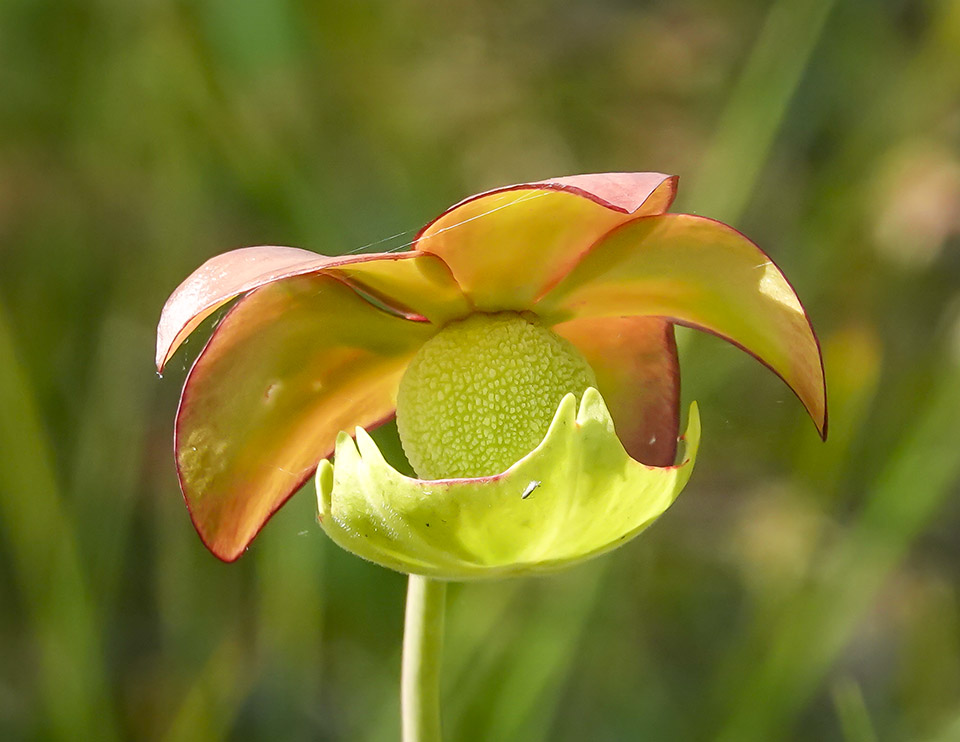
The Pitcher Plant's other readily identifiable feature is its single, nodding flower. The flower, which is two to three inches wide, appears on the top of a thick, leafless stalk up to two feet tall. The petals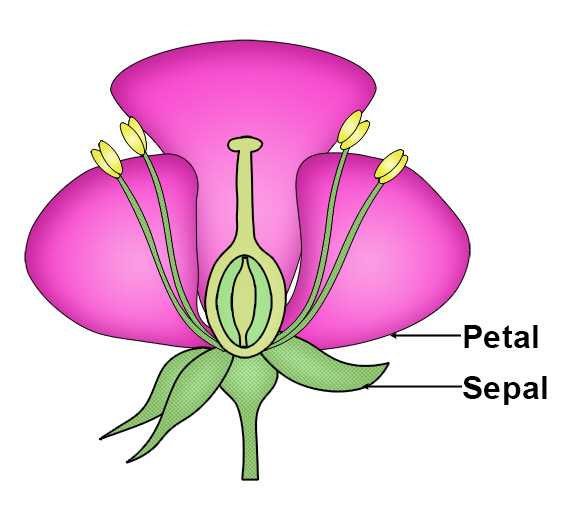 Petals: Modified leaves that surround the reproductive parts of flowers. Petals are often brightly colored or unusually shaped to attract pollinators. are bright red and rounded, staying on the plant briefly before being shed.
Petals: Modified leaves that surround the reproductive parts of flowers. Petals are often brightly colored or unusually shaped to attract pollinators. are bright red and rounded, staying on the plant briefly before being shed.
The rest of the rigid flower structure persists all summer into fall. This consists of five somewhat more pointed sepals.gif) Sepals: The parts that look like little green leaves and cover the outside of a flower bud to protect the flower before it opens., with incurving tips. The sepals are generally tinged with dark red or red-purple on the outside and yellow on the inside. The sepals curve around a yellowish-green style
Sepals: The parts that look like little green leaves and cover the outside of a flower bud to protect the flower before it opens., with incurving tips. The sepals are generally tinged with dark red or red-purple on the outside and yellow on the inside. The sepals curve around a yellowish-green style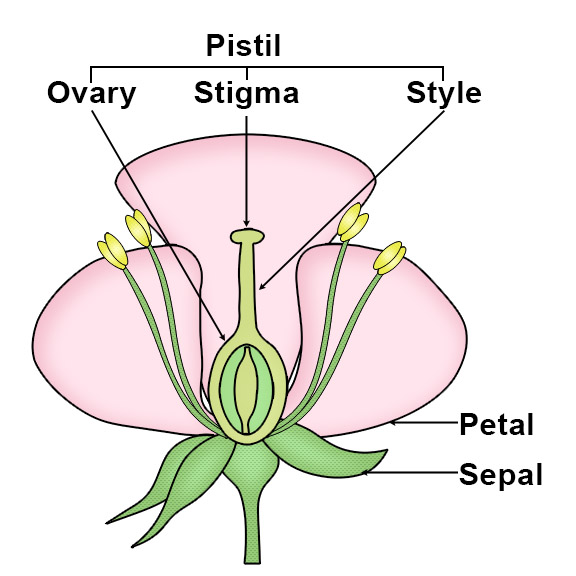 Style: The narrow, elongated part of the pistil between the ovary and the stigma. The style is part of the pistil (the female organs of a flower), which also consists of an ovary and a stigma. The style is the stalk that connects the stigma to the ovary., which expands into an umbrella-like structure, sometimes splashed with deep red. The Pitcher Plant has numerous stamens
Style: The narrow, elongated part of the pistil between the ovary and the stigma. The style is part of the pistil (the female organs of a flower), which also consists of an ovary and a stigma. The style is the stalk that connects the stigma to the ovary., which expands into an umbrella-like structure, sometimes splashed with deep red. The Pitcher Plant has numerous stamens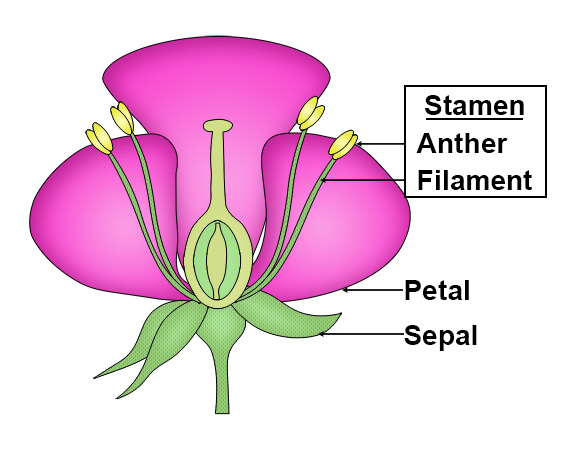 Stamen: The male part of the flower, made up of the filament and anther. which are largely hidden by the style.
Stamen: The male part of the flower, made up of the filament and anther. which are largely hidden by the style.
The Pitcher Plant's flower pollinators include bumblebees (Bombus) and honeybees (Apis mellifera). Pitcher Plants are also pollinated by the Pitcher Plant Fly (Fletcherimyia fletcheri), which becomes covered with pollen while seeking shelter in the flowers.
In the Adirondacks, Pitcher Plants generally start blooming in early- to mid-June. The flowers (minus the petals, which are very fleeting) persist through the summer and into early September, depending on the weather.
The fruit of the Pitcher Plant is a round, five-celled seed capsule. The capsule is about ¾ inch in diameter and changes from green to yellow to red to brown, before splitting open to expose the numerous brown seeds.
Uses of Pitcher Plant
Native American tribes reportedly used the Pitcher Plant to treat a variety of ailments, including lower back pain, fever, chills, whooping cough, pneumonia, and kidney problems. Some groups, such as the Algonquin, employed an infusion of leaves as an aid to childbirth; the Cree reportedly gave a decoction of the root to women to prevent sickness after childbirth.
The plant was also used by several Native American groups as a treatment and preventative for small pox, although reports conflict on its effectiveness.
Wildlife Value of Pitcher Plant
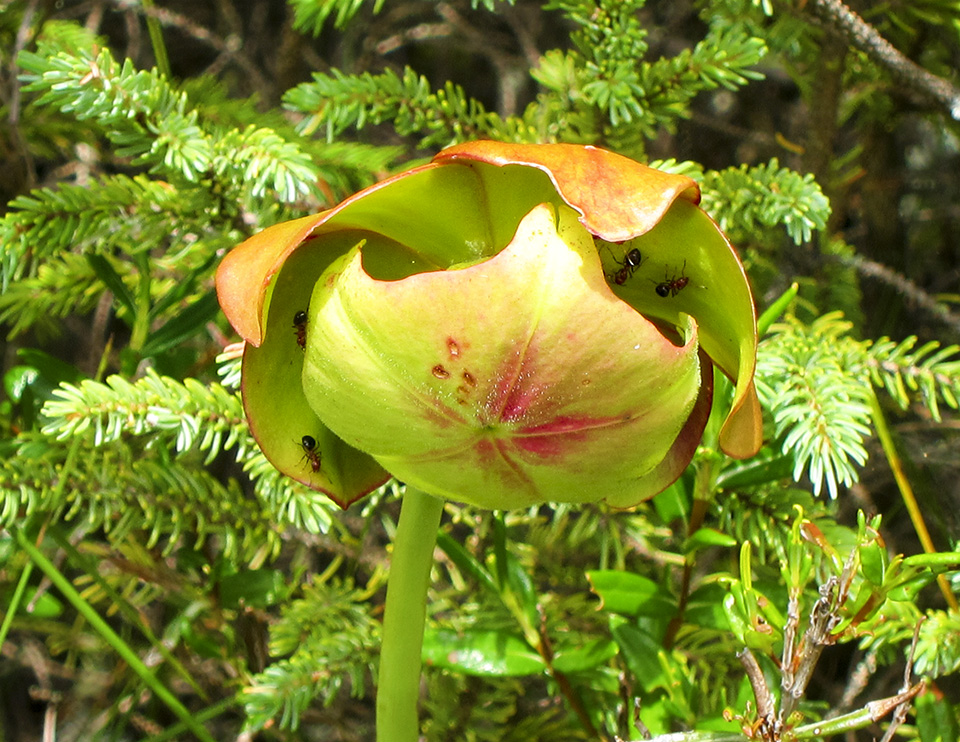
Pitcher Plants provide benefits to several insect species.
- The plant hosts a variety of anthropod species who live in the pitchers and feed upon the Pitcher Plant's decomposing insect victims. These organisms are able to survive by relying on anti-enzymes to counteract the digestive enzymes in the fluid. Examples include the larvae of the Pitcher Plant Fly, the Pitcher Plant Midge, and the Pitcher Plant Mosquito. Another common fly inhabitant is the Eastern Flesh Fly.
- Some spiders spin webs across the mouths of the pitchers to catch entering insects.
- The caterpillars of several moths feed on the Pitcher Plant. Examples include the Epauletted Pitcher Plant Moth (whose caterpillars feed on the inner surface of the leaves) and the Pitcher Plant Borer Moth (whose caterpillars feed on the Pitcher Plant's roots).
- Pitcher-plant Aphids feed on the buds and flowers.
Pitcher Plants are of limited value to mammals. White-footed Mice, Meadow Voles, and Snowshoe Hares are said to feed on Pitcher Plants.
Distribution of Pitcher Plant
The Pitcher Plant's range includes the eastern seaboard of the United States, the Great Lakes, and south eastern Canada. It can be found from Saskatchewan to Labrador and Nova Scotia; south through New England to Florida; west to Texas; and north to Indiana, Illinois, and Minnesota. It is rare in most of its southeastern U.S. range.
The plant is listed as threatened in Florida and Maryland, endangered in Georgia and Illinois, and exploitably vulnerable in New York State, where it is protected. In New York State, it is listed in two categories: "rare" (21 to 100 occurrences, limited acreage, or miles of stream) and "apparently secure."
The Pitcher Plant has been documented in all counties within the Adirondack Park Blue Line, except Oneida County.
Habitat of Pitcher Plant
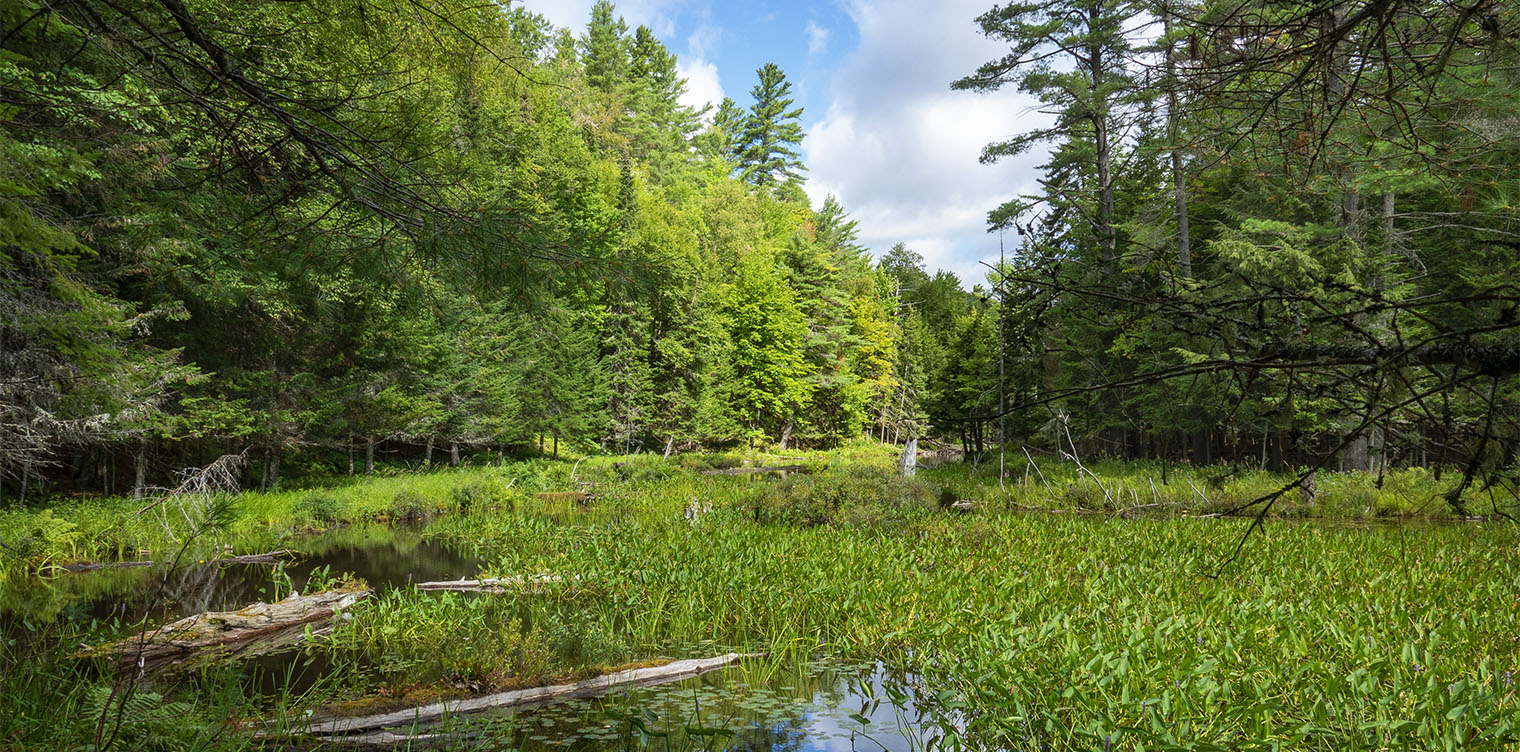
The Pitcher Plant is an obligate wetland species, meaning that it almost always occurs in wetland areas. It grows in moist peat in sphagnum bogs and acidic fens and along peaty shorelines.
In the Adirondack Mountains, the Pitcher Plant is found in several wetland ecological communities:
Pitcher Plants can be seen at the Paul Smith's College VIC in Barnum Bog, where they may be observed from the boardwalk on the Boreal Life Trail. Pitcher Plants also grow in the wetland areas around Black Pond and may be seen from the Black Pond Trail.
References
Michael Kudish. Adirondack Upland Flora: An Ecological Perspective (The Chauncy Press, 1992), pp. 24, 54-55, 132, 242, 245.
New York Flora Association. New York Flora Atlas. Purple Pitcherplant. Sarracenia purpurea L. Retrieved 18 March 2019
United States Department of Agriculture. The Plants Database. Purple Pitcherplant. Sarracenia purpurea L. Retrieved 28 October 2017.
United States Department of Agriculture. Fire Effects Information System (FEIS). Species Reviews. Sarracenia purpurea. Retrieved 28 October 2017.
United States Department of Agriculture. Forest Service. Plant of the Week. Purple Pitcherplant. Retrieved 28 October 2017.
Flora of North America. Sarracenia purpurea Linnaeus. Retrieved 28 October 2017.
NatureServe Explorer. Online Encyclopedia of Life. Northern Pitcherplant. Sarracenia purpurea - L. Retrieved 28 October 2017.
Native Plant Trust. Go Botany. Purple Pitcherplant. Sarracenia purpurea L. Retrieved 31 October 2017.
New York State. Department of Environmental Conservation. New York Natural Heritage Program. Ecological Communities of New York State. Second Edition (March 2014), pp. 60, 60-61, 63-64, 64, 76. Retrieved 17 October 2015.
New York Natural Heritage Program. 2019. Online Conservation Guide for Black Spruce-Tamarack Bog. Retrieved 18 March 2019.
New York Natural Heritage Program. 2019. Online Conservation Guide for Dwarf Shrub Bog. Retrieved 18 March 2019.
New York Natural Heritage Program. 2019. Online Conservation Guide for Inland Poor Fen. Retrieved 18 March 2019.
New York Natural Heritage Program. 2019. Online Conservation Guide for Medium Fen. Retrieved 18 March 2019.
New York Natural Heritage Program. 2019. Online Conservation Guide for Patterned Peatland. Retrieved 18 March 2019.
New York State. Adirondack Park Agency. Preliminary List of Species Native Within the Adirondack Park Listed Alphabetically by Scientific Name and Sorted by Habit. Volume 1. Updated 10.23.2006, p. 35. Retrieved 26 January 2017.
USA National Phenology Network. Nature’s Notebook. Sarracenia purpurea. Retrieved 31 October 2017.
Connecticut Botanical Society. Northern Pitcher-plant (Purple Pitcher-plant). Sarracenia purpurea L. Retrieved 31 October 2017
Botanical Society of America. Sarracenia purpurea - The Purple Pitcher Plant. Retrieved 1 November 2017.
Minnesota Wildflowers. Sarracenia purpurea. Retrieved 1 November 2017.
Illinois Wildflowers. Northern Pitcher Plant. Sarracenia purpurea. Retrieved 1 November 2017.
Illinois Wildflowers. Fletcherimyia fletcheri Aldrich: Sarcophagidae, Diptera. Retrieved 3 November 2017.
Lady Bird Johnson Wildflower Center. Sarracenia purpurea L. 1 November 2017.
Online Encyclopedia of Life. Sarracenia purpurea. Purple Pitcherplant. Retrieved 1 November 2017.
iNaturalist. Adirondack Park Observations. Purple Pitcher Plant. Sarracenia purpurea. Retrieved 28 January 2020.
Anne McGrath. Wildflowers of the Adirondacks (EarthWords, 2000), p. 73.
Roger Tory Peterson and Margaret McKenny. A Field Guide to Wildflowers. Northeastern and North-central North America (Houghton Mifflin Company, 1968), pp. 230-231.
Doug Ladd. North Woods Wildflowers (Falcon Publishing, 2001), p. 62.
Lawrence Newcomb. Newcomb's Wildflower Guide (Little Brown and Company, 1977), pp. 182-183.
Charles W. Johnson. Bogs of the Northeast (University Press of New England, 1985), p. 111-117.
Meiyin Wu & Dennis Kalma. Wetland Plants of the Adirondacks: Herbaceous Plants and Aquatic Plants (Trafford Publishing, 2011), p. 119.
Ronald B. Davis. Bogs & Fens. A Guide to the Peatland Plants of the Northeastern United States and Adjacent Canada (University Press of New England, 2016), pp. 190-191.
Donald D. Cox. A Naturalist's Guide to Wetland Plants. An Ecology for Eastern North America (Syracuse University Press, 2002), pp. 86-87.
David M. Brandenburg. Field Guide to Wildflowers of North America (Sterling Publishing Company, Inc., 2010), pp. 494-495.
John Kricher. A Field Guide to Eastern Forests. North America (Houghton Mifflin, 1998), pp. 68-69.
Timothy Coffey. The History and Folklore of North American Wildflowers (FactsOnFile, 1993), pp. 69-70.
National Audubon Society. Field Guide to North American Wildflowers. Eastern Region. (Alfred A. Knopf, 2001), pp. 772-773.
William K. Chapman et al. Wildflowers of New York in Color (Syracuse University Press, 1998), pp. 52-53.
John Eastman. The Book of Swamp and Bog: Trees, Shrubs, and Wildflowers of Eastern Freshwater Wetlands (Stackpole Books, 1995), pp. 143-148.
Plants for a Future. Sarracenia purpurea - L. Retrieved 1 November 2017.
Steven Foster and James A. Duke. Medicinal Plants and Herbs of Eastern and Central North America (Houghton Mifflin Harcourt, 2014), pp. 161-162.
University of Michigan. Native American Ethnobotany. A Database of Foods, Drugs, Dyes and Fibers of Native American Peoples, Derived from Plants. Sarracenia purpurea L. Purple Pitcherplant. Retrieved 1 November 2017.
Iowa State University. BugGuide. Genus Wyeomyia. Retrieved 1 November 2017.
Iowa State University. BugGuide. Genus Exyra - Pitcherplant Moths. Retrieved 1 November 2017.
Allen J. Coombes. Dictionary of Plant Names (Timber Press, 1994), p. 166.
Charles H. Peck. Plants of North Elba. (Bulletin of the New York State Museum, Volume 6, Number 28, June 1899), p. 76. Retrieved 22 February 2017.
Dictionary of Canadian Biography. Sarrazin (Sarrasin), Michel. Retrieved 2 November 2017.
Wildflowers of the Adirondack Park
